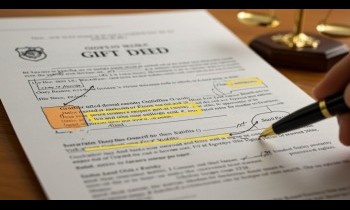How To Change Surname Legally In India?

Date : 22 Jul, 2023
Post By admin
Changing ones’ name has become a common practice nowadays. It may include addition or deletion of an initial from an existing name or this may also include complete change in name. The change may be of the first name, middle name and/or surname. The procedure for name change remains the same even if it is a single letter is to be change or one wishes to change complete name, it makes no difference.
In India, women change their name after marriage by changing their surnames and adding their husband’s surname. This is considered as a sign of respect towards the husband and his family, it also gives a feeling of belongingness. In this article we will guide you about the entire step-by-step name change procedure.
What Is A Name Change?
Let’s first understand what is name change actually mean? Name change refers to the legal process of where an individual wishes to change name, that is different from the person’s birth certificate name, or adoption name, etc. It also includes change of one’s surname.
You must note that a name change has legal implication, and once you have changed your name then you must all your social media accounts, bank accounts, certificates, documents, etc. You must be careful while opting for a name change as once it is changed then your changed name will be your new name and you cannot use your previous name anywhere.
Examples of name change
Everybody has his/ her own reason to change name. The reason may be marriage, adoption, divorce, religion, astrology, etc. For example: Some astrologers suggest that having more vowels in your name make you lucky and hence many people add ‘A’ or ‘E’ to their names.
Let’s discuss a real life example that is very interesting, recently Taapsee Pannu the famous Bollywood actress revealed that her dad named her Tapasee as a name with a pronunciation of TAPASI in not lucky in numerology and it wasn't good enough. Hence, her name needed to have two Es, and an extra A, for some reason. So there can be such reasons where people change their names, some may change to sound it more interesting and easy to remember.
Another example we can take of the famous Bollywood queen Bebo, who changed her name to Mrs. Kareena Kapur Khan. She added her husband’s surname after her name and changed it to KKK. These are some examples of famous celebrities who have changed their names for different reasons.
Procedure for surname change in India
Now let’s discuss the procedure of changing surname in India. As we have discussed above that whether you opt. to change one alphabet by adding or deleting it, or your change your complete name or surname, the procedure would remain the same. Below is the step-by step procedure guide for you to understand better.
There are three crucial and mandatory steps that you need to comply with while changing your surname:
1. Prepare an affidavit: The first step is to prepare an affidavit and take a print out of the same on stamp paper that needs to be attested by a notary. In the affidavit, you must mention the following details:
☑️ Your old and the new name;
☑️ You must mention the reason for the change of your surname;
☑️ Mention your current address.
This affidavit is a significant legal document for all future references, filings and legal formalities. Hence, cross-verify the details mentioned in the affidavit including the spelling of your surname.
2. Newspaper Publication: The next step is to publish a notification or advertisement of your change in surname in at least 2 local newspapers. One must be an English newspaper and another must be a regional newspaper published in the official language of the State. The details that needs to be mentioned in the newspaper notification/ advertisement are:
☑️ The applicant must mention his/ her new surname and old surname; if you are removing your surname then the old full name and new name, must be mentioned;
☑️ Mention your residential address.
The copies of newspapers notification/ advertisement with the name change published must be secured safely and held by you for future use and reference.
3. Gazette Notification: This is the last step but very crucial and must not to be skipped. A change in the name or surname is legally complete once the same is published in a Gazette notification.
Gazette notification of a name change is a compulsion for employees employed by the Government and although it is optional for others but advisable to not skip this step. This is served as a substantial proof of name or surname change. You might wonder that when it is optional then it is better to skip this step but as discussed above it is a very significant step while changing your name.
Documents needed for name change
☑️ You need an affidavit on a stamp paper;
☑️ You need the newspaper with the advertisement given regarding name change;
☑️ The prescribed proforma is needed in printed format, that must be duly signed by you and it must also be signed by two witnesses;
☑️ Two passport size photographs
☑️ Photocopies of valid ID proof including passport or aadhar card or pancard;
☑️ A CD is required with a soft copy of the application in .docx format;
☑️ The original ad that was printed in the newspaper notifying the change in name;
☑️ A letter is required that contains that the content in the hard and soft copies of the application is credible;
☑️ Registration fee in form of demand draft to the authority.
FAQS
Q1: Who can change their surname?
Ans: The following persons can change their surname:
☑️ The applicant must be an Indian.
☑️ They must have a relevant identity proof; for example if surname is to be changed due to marriage then marriage certificate be shown as a proof.
☑️ The applicant must have a justified reason to change their name.
☑️ The applicant must be a major i.e. must have completed 18 years of age.
☑️ Minors must be accompanied by their parents during the visit to a government agency for surname change.
Q2: Who can apply for a surname change?
Ans: The following can apply for their surname change:
☑️ The person himself/ herself;
☑️ A guardian can apply for the minor;
☑️ Either husband or wife can apply, on behalf of the other.
☑️ A family relative can also apply.
Q3: Are there any restrictions on change in name?
Ans: As per the laws in India, people can freely change their names of their choice. However, there are a few restrictions, which are listed below:
☑️ The name should not be insulting.
☑️ The intention of name change should not be deceiving or for the purpose of fraud.
☑️ No name change merely to conceal your identity, such an act cannot be permitted.
☑️ You cannot change name to dodge financial obligations or legal troubles.
Q4: How much fees is charged for change of surname?
Ans: ☑️ Stamp Paper – Rs. 5/- or Rs. 10/-
☑️ Printing Fee – Rs. 1100/-
☑️ Gazette notice including airmail (for NRIs)- Rs. 3500/-
☑️ Extra Copies of the Gazette (Maximum two) – Rs. 35/- each
Q5: What is the offline procedure to change my surname?
Ans: You need to follow the following steps:
☑️ Submission of an affidavit;
☑️ Publication of an advertisement in the newspapers; and
☑️ Notification in the Gazette.
This article was written by Shivangi Dubey, an extremely established lawyer. Shivangi Dubey holds a BSL-LLB degree from ILS Pune & also is a gold medalist in LLM-Business laws from Amity University. With 12 years of experience in the law domain, she has established herself as an expert in her field. Presently, Shivangi works as an Advocate at the Directorate of Enforcement (ED), Government of India. Her expertise as well as insights have considerably added to the content of this article.
Read Our Blog On : Famous Personalities Who Changed Their Names in India






Shivam Kumar